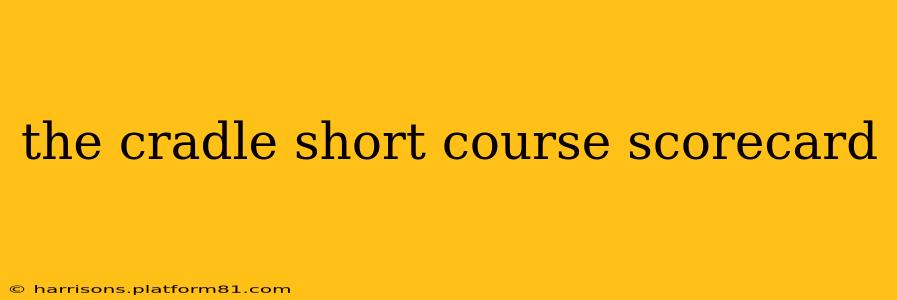The Cradle short course, known for its challenging layout and strategic play, requires a scorecard that accurately reflects the player's performance. While a standardized scorecard isn't universally published for The Cradle (assuming a specific course with that name), the principles for understanding and utilizing a short course scorecard remain the same. This guide will explain how to interpret and use a scorecard for any short course, including one that might be called "The Cradle."
What is a typical short course scorecard?
A typical short course scorecard differs slightly from a standard 18-hole course. It will usually include:
- Fewer holes: Short courses can range from 6 to 18 holes, but most commonly feature 9 holes.
- Par values: Par for each hole will be lower, typically between par 2 and par 4. You'll find a par 3 is quite common on short courses.
- Yardages: The distances for each hole are significantly shorter than on a full-length course.
- Total Par: The total par for the course is the sum of the par values for each hole.
- Scoring Space: Ample space is provided for recording each shot's score for each hole. This allows you to track your performance hole-by-hole.
How to Use a Short Course Scorecard like a Pro
Using a scorecard correctly is crucial for accurately tracking your progress and comparing scores over time. Here's how:
- Identify the Holes: Ensure you know which hole you're playing and its par.
- Record each Stroke: After each shot, meticulously record the number of strokes it took you to complete that hole. Be precise – accuracy is key.
- Calculate Your Score for Each Hole: Once you finish a hole, check if your score is over or under par for that specific hole. This provides valuable insights into your game.
- Sum Your Scores: After completing all holes, add up your scores for each hole to arrive at your total score for the round.
- Compare to Par: Subtract the total par of the course from your total score to determine your score relative to par (e.g., +2, -1, etc.). This is a standardized way of comparing scores across different courses.
What are some common scoring methods used in short courses?
While individual strokes are the most common method, some short courses may use alternative scoring methods such as:
- Stableford: Points are awarded based on the score relative to par. For example, you might get 2 points for a birdie (one under par), 1 point for par, and 0 for a bogey (one over par).
- Modified Stableford: This adjusts the point system, perhaps offering more points for birdies or penalizing double bogeys more severely.
How can I improve my score on a short course like The Cradle?
Improving your short course game involves focusing on several key areas:
- Short Game Mastery: Accuracy with your short irons, wedges, and putting is critical on a short course. Practice your chipping, pitching, and putting to significantly impact your scores.
- Course Management: Strategic shot selection becomes paramount on a short course. Don’t always try to reach the green in one shot if a safer, more accurate approach will give you a better chance at par.
- Putting: Many short courses have undulating greens that demand skillful putting. Improve your reading and lag putting skills.
Where can I find a scorecard for The Cradle?
Unfortunately, without knowing the specific location of "The Cradle" short course, it's impossible to provide a link to a scorecard. To find a scorecard, you'll likely need to:
- Contact the golf course directly: This is the most reliable way. Check their website or call them for a scorecard.
- Visit the course: You can obtain a scorecard when you arrive to play.
Remember, the core principles of scoring remain the same regardless of the specific course. By following these tips and understanding the principles explained here, you can effectively utilize any short course scorecard to track your game and improve your skills.
